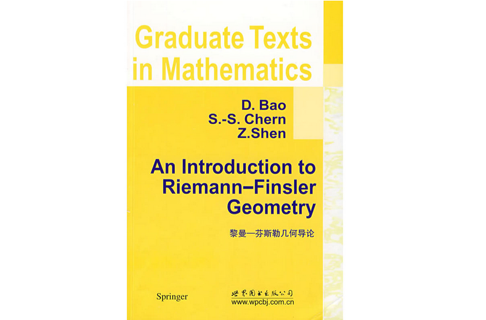《黎曼:芬斯勒幾何導論》是一本(美國)鮑編寫,由世界圖書出版公司在2009年出版的書籍。全書分為3部分,全面介紹了黎曼:芬斯勒幾何導論的基本概念和研究成果。
基本介紹
- 書名:黎曼:芬斯勒幾何導論
- 又名:An Introduction to Riemann-Finsler Geometry
- ISBN:7510005051, 9787510005053
- 開本: 24
圖書信息,作者簡介,內容簡介,目錄,
圖書信息
平裝: 425頁
正文語種: 英語
開本: 24
ISBN: 7510005051, 9787510005053
條形碼: 9787510005053
尺寸: 22.4 x 14.8 x 1.8 cm
重量: 558 g
作者簡介
作者:(美國)鮑
內容簡介
《黎曼:芬斯勒幾何導論(英文版)》講述了:The subject matter of this book had its genesis in Riemann's 1854 "habil-itation" address: "Uber die Hypothesen, welche der Geometrie zu Grundeliegen" (On the Hypotheses, which lie at the Foundations of Geometry).Volume II of Spivak's Differential Geometry contains an English translationof this influential lecture, with a commentary by Spivak himself. Riemann, undoubtedly the greatest mathematician of the 19th century,aimed at introducing the notion of a manifold and its structures. The prob-lem involved great difficulties. But, with hypotheses on the smoothness ofthe functions in question, the issues can be settled satisfactorily and thereis now a complete treatment. Traditionally, the structure being focused on is the Riemannian metric,which is a quadratic differential form. Put another way, it is a smoothlyvarying family of inner products, one on each tangent space. The resultinggeometry —— Riemannian geometry —— has undergone tremendous develop-ment in this century. Areas in which it has had significant impact includeEinstein's theory of general relativity, and global differential geometry. In the context of Riemann's lecture, this restriction to a quadratic dif-ferential form
目錄
Preface
Acknowledgments
PART ONE
Finsler Manifolds and Their Curvature
CHAPTER 1
Finsler Manifolds and
the Fundamentals of Minkowski Norms
1.0 Physical Motivations
1.1 Finsler Structures: Definitions and Conventions
1.2 Two Basic Properties of Minkowski Norms
1.2 A. Enler's Theorem
1.2 B. A Fundamental Inequality
1.2 C. Interpretations of the Fundamental Inequality .
1.3 Explicit Examples of Finsler Manifolds
1.3 A. Minkowski and Locally Minkowski Spaces
1.3 B. Riemannian Manifolds
1.3 C. Randers Spaces
1.3 D. Berwald Spaces
1.3 E. Finsler Spaces of Constant Flag Curvature
1.4 The Fundamental Tensor and the Cartan Tensor
Referenees for Chapter 1
CHAPTER 2
The Chern Connection
2.0 Prologue
2.1 The Vector Bundleand Related Objects
2.2 Coordinate Bases Versus Special Orthonormal Bases
2.3 The Nonlinear Connection on the Manifold TM \O
2.4 The Chern Connection on
2.5 Index Gymnastics
2.5 A. The Slash (..-)s and the Semicolon (...);s
2.5 B. Covariant Derivatives of the Fundamental Tensor g
2.5 C. Covariant Derivatives of the Distinguished
References for Chapter 2
CHAPTER 3
Curvature and Schur's Lemma
3.1Conventions and the hh-, hv-, w-curvatures
3.2First Bianchi Identities from Torsion Freeness
3.3Formulas for R and P in Natural Coordinates
3.4First Bianchi Identities from "Almost" g-compatibility
3.4 A. Consequences from the
3.4 B. Consequences from the
3.4 C. Consequences from the
3.5Second Bianchi Identities
3.6Interchange Formulas or Ricci Identities
3.7Lie Brackets among the
Oy
3.8Derivatives of the Geodesic Spray Coefficients
3.9The Flag Curvature
3.9 A. Its Definition and Its Predecessor
3.9 B. An Interesting Family of Examples of Numata Type
3.10 Schur's Lemma
References for Chapter 3
CHAPTER 4
Finsler Surfaces and
a Generalized Gauss-Bonnet Theorem
4.0 Prologue
4.1 Minkowski Planes and a Useful Basis
4.1 A. Rund's Differential Equation and Its Consequence
4.1 B. A Criterion for Checking Strong Convexity
4.2 The Equivalence Problem for Minkowski Planes
4.3 The Berwald Frame and Our Geometrical Setup on SM
4.4 The Chern Connection and the Invariants I, J, K
4.5 The Riemannian Arc Length of the Indicatrix
4.6 A Gauss-Bonnet Theorem for Landsberg Surfaces
References for Chapter 4
PART TWO
Calculus of Variations and Comparison Theorems
CHAPTER 5
Variations of Arc Length,
Jacobi Fields, the Effect of Curvature
5.1 The First Variation of Arc Length
5.2 The Second Variation of Arc Length
5.3 Geodesics and the Exponential Map
5.4 Jacobi Fields
5.5 How the Flag Curvature's Sign Influences Geodesic Rays
References for Chapter 5
CHAPTER 6
The Gauss Lemma and the Hopf-Rinow Theorem
6.1 The Gauss Lemma
6.1 A. The Gauss Lemma Proper
6.1 B. An Alternative Form of the Lemma
6.1 C. Is the Exponential Map Ever a Local Isometry?
6.2 Finsler Manifolds and Metric Spaces
6.2 A. A Useful Technical Lemma
6.2 B. Forward Metric Balls and Metric Spheres
6.2 C. The Manifold Topology Versus the Metric Topology .
6.2 D. Forward Cauchy Sequences, Forward Completeness .
6.3 Short Geodesics Are Minimizing
6.4 The Smoothness of Distance Functions
6.4 A. On Minkowski Spaces
6.4 B. On Finsler Manifolds
6.5 Long Minimizing Geodesics
6.6 The Hopf-Rinow Theorem
References for Chapter 6
CHAPTER 7
The Index Form and the Bonnet-Myers Theorem
7.1 Conjugate Points
7.2 The Index Form"
7.3 What Happens in the Absence of Conjugate Points?
7.3 A. Geodesics Are Shortest Among "Nearby" Curves ...
7.3 B. A Basic Index Lemma
7.4 What Happens If Conjugate Points Are Present?
7.5 The Cut Point Versus the First Conjugate Point
7.6 Ricci Curvatures
7.6 A. The'Ricci Scalar Ric and the Ricci Tensor Ricij
7.6 B. The Interplay between Ric and Ricij
7.7 The Bonnet-Myers Theorem
References for Chapter 7
CHAPTER 8
The Cut and Conjugate Loci, and Synge's Theorem
8.1 Definitions
8.2 The Cut Point and the First Conjugate Point
8.3 Some Consequences of the Inverse Function Theorem
8.4 The Manner in WhichandDepend on y
8.5 Generic Properties of the Cut Locus
8.6 Additional Properties of Cutx When M Is Compact
8.7 Shortest Geodesics within Homotopy Classes
8.8 Synge's Theorem
References for Chapter 8
CHAPTER 9
The Cartan-Hadamard Theorem and
Rauch's First Theorem
9.1 Estimating the Growth of Jacobi Fields
9.2 When Do Local Diffeomorphisms Become Covering Maps? .
9.3 Some Consequences of the Covering Homotopy Theorem ...
9.4 The Cartan-Hadamard Theorem
9.5 Prelude to Rauch's Theorem
9.5 A. Transplanting Vector Fields
9.5 B. A Second Basic Property of the Index Form
9.5 C. Flag Curvature Versus Conjugate Points
9.6 Rauch's First Comparison Theorem
9.7 Jacobi Fields on Space Forms
9.8 Applications of Rauch's Theorem
References for Chapter 9

